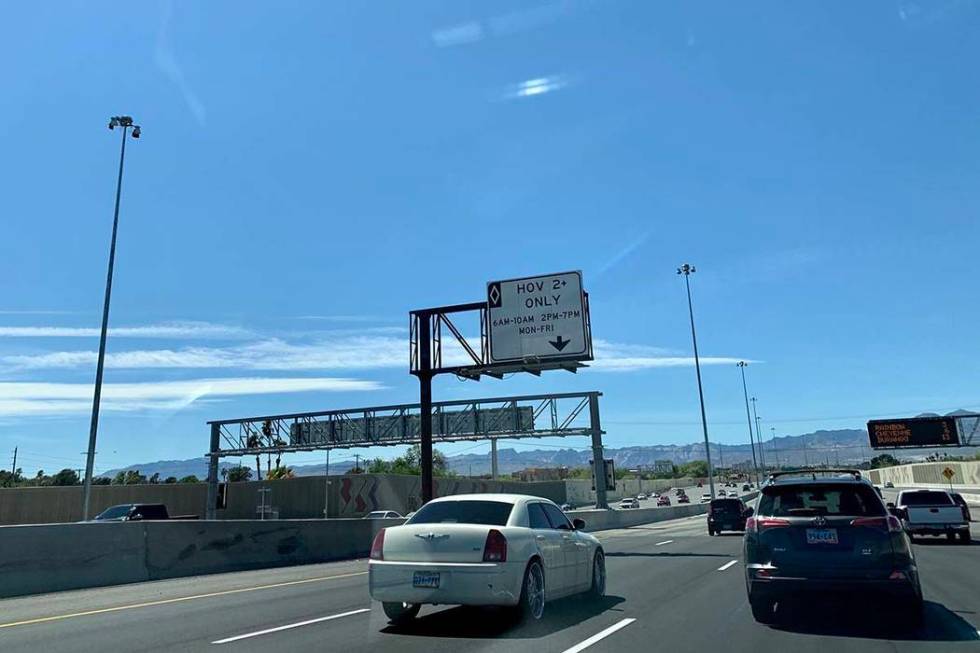New HOV regulations spark outcry, but lanes do serve a purpose

The Nevada Department of Transportation made the rounds at various local government meetings to announce pending changes to how high-occupancy vehicle lanes will be governed starting next month.
The new rules will go into effect in mid-May when two Interstate 15 express lanes are restriped as a single HOV lane and a general-purpose lane. The major new features include 24 hour a day, seven day a week enforcement of the lanes, no crossing the double solid line to enter/exit the HOV lanes and no electric vehicles with a single occupant allowed, among other rules.
After a grace period when the new rules are implemented, anyone found in violation of the new regulations will face a $250 fine.
Following the announcements of the new regulations, some officials and residents alike aired their displeasure.
Las Vegas City Councilman Stavros Anthony said if it were up to him he wouldn’t allow HOV lanes to exist. He also called for a public comment period and more discussion at next month’s council meeting.
Jeff Short took to Twitter to question why electric vehicles with a single occupant won’t be allowed to use the HOV lanes as they are in other jurisdictions.
“Why not electric vehicles?” Short tweeted. “There’s a law that allows it, NDOT needs to set regulations.”
NDOT replied to Short stating that it’s currently not allowed by Nevada law. It said the department would monitor the HOV lanes once the new regulations are in place, but cautioned motorists to adhere to the rules or face a fine.
“Electric and hybrid vehicles must have dual passengers to qualify for HOV lane travel or face a $250 fine,” NDOT’s Twitter account said.
Federal officials defend the use of HOV lanes and argue they serve a worthwhile purpose.
HOV lanes are a vital attraction for ride-sharing, which reduces vehicle trips and results in decreased traffic congestion, according to the Federal Highway Administration.
Since vehicles using carpool lanes contain more occupants, HOV lanes can carry more passengers per hour than general-purpose highway lanes, the FHWA reported.
The FHWA also said HOV facilities outperform adjacent general-purpose highway lanes in terms of person throughput, especially during peak hours of service.
Approximately 70 percent of the nation’s HOV lane miles operate with peak hour volumes of between 900 and 1,500 vehicles per hour, the administration reported.
Some jurisdictions where usage falls below that threshold have turned to charging single passenger vehicles a fee in return for using the carpool lanes. The lanes are deemed high occupancy toll (HOT) lanes.
For either a set fee or one that varies depending on time of day and traffic volume, motorists are allowed to travel on HOT lanes driving alone.
The implementation of HOT lanes enables local transportation officials to ensure the HOV lanes aren’t under-used. It also generates new revenue that can be used to support the construction of the HOT lanes themselves or other road projects, the FHWA said.
HOT lanes were considered by NDOT ahead of the Project Neon planning, but the department wasn’t able to receive the approval ahead of the 3-year long project’s start.
“We (NDOT) studied HOT lanes and thought they would be a viable solution,” said Adrienne Packer, NDOT spokeswoman. “We attempted to implement legislation before Project Neon work began, but the legislation did not pass. So, we don’t have the legislative authority to do so.”
NDOT may revisit the possibility of HOT lanes in the future after officials assess the initial performance of the new HOV lanes and the regulations surrounding them.
“It’s a possibility in the future if the legislature is receptive,” Packer said.
Martin Luther King lane restriction
Lane restrictions on a stretch of Martin Luther King Boulevard in downtown Las Vegas will affect commutes for the next week.
The inside lane along Martin Luther King north and southbound between U.S. Highway 95 and Mineral Avenue shut to traffic April 16 and will remain closed until 6 a.m. April 27, the Nevada Department of Transportation announced last week.
The temporary restrictions are needed for paving work as part of Project Neon, the nearly $1 billion, 4-mile-long widening of Interstate 15 from the U.S. 95 interchange to Sahara Avenue.
Project Neon is 95 percent finished and scheduled for substantial completion in May.
Send questions and comments to roadwarrior@reviewjournal.com. Please include your phone number. Follow @RJroadwarrior on Twitter. Contact Mick Akers at makers@reviewjournal.com or 702-387-2920. Follow @mickakers on Twitter.